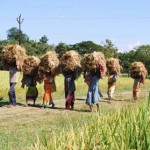World agriculture scenario is more important!
For Indian agriculture successes and its future courses!
Yes, we have to become a more mature nation to push our agri sector forward towards a more sustained growth path.
 For this to become our day to day talk of Indian agriculture and the larger vision for a more stable rural India possible, we have to become more mature in reading and understanding Indian agriculture.
For this to become our day to day talk of Indian agriculture and the larger vision for a more stable rural India possible, we have to become more mature in reading and understanding Indian agriculture.
For a change we want our readers to look at Indian agriculture scenario in an international context.
As things stand, the world food stocks, the food prices are rather in a comfortable position. The word “comfortable” should not give any wrong meaning. We are accustomed to talk too much about the hunger and poverty, to much about the poor without adequate food supplies etc. This is right and we should be aware of the challenges for the government to pursue policies.
But then, there is the larger world outside India. The world’s poorer states in Africa have biggest challenges.
On the other hand, there are the world’s more developed countries with stronger agriculture bases.
Then there is the growing and expanding world trade. World trade in agricultural commodities.
One big slice is the world trade in food grains.
Now, as things stand, at the end of the December season 2008, the FAO estimated that 33 countries were experiencing severe or moderate food crises, with conditions in at least 17 countries worse compared to October 2008.
This is not because of any decline in food supplies or sudden increased demand for food. In fact, the aggregate conditions pointed to adequate global food grains markets. Stable markets, adequate supplies and even slightly declining food prices. In fact rice supplies increased more than consumption. China and India continued to show falling food grains consumption both in per capita terms as well as in the aggregate, completely belying the view that increased demand from these countries contributed to the partial global food prices rise.
It is seen that in China, a large economy, as well as in India, another larger economy, we see the food prices remaining rather stable, though the average food prices have risen as high as 60 per cent higher in January 2009,that is between 2007 to 2008 and 2009.Though we see that in some of the other developing African countries the food prices have soared so high as high as 994 per cent in, say, Zimbabwe(between 2008 and 2009), almost as high as 100 per cent in all the African countries, in Afghanistan and Pakistan too the rise is so high as 100 per cent, only in Brazil, the retail rice price was higher by 43 per cent. So, Indian food prices, their rises is no big news seen from outside India!
India has a strong rice and wheat production base. Our rice production base is many times larger than our rice export trade base.
Yes, it is true that more than half of our population is calorie-deficit. That is another matter and how to reduce and control the calorie deficit, tackling poverty and food purchase habits. PDS, as it is in the states has much to do with it. Free rice promises in election times and the free rice schemes pursued by various states also have some impact.
But the point is that whether India is food security insured or not is also a different question and needs answer in a different manner. Different from what we have been told so far or what we have been accustomed to or listen to our politicians.
The point here is that agriculture is a critical sector in each and every country in the world, big and small, developed and developing ones. Given this perspective, we also need to become more realistic about our basic agricultural policy for the country. India, like China, is a large country, large geography and large economy. So, there is much challenge and also much opportunity to produce and distribute and stabilise our food prices. Also, India has to play a big role in international and even regional roles in helping to stabilise the economies in the regions. So, we have to play an active and positive role in FAO, in WTO and also in the many international and humanitarian programmes.
So, our national agricultural policy has to be realistic and so we have to integrate and also reform our economic and trade policies.
Then, agriculture trade and more so the word, trade reforms is a very tricky word.
The USA wants to push the WTO reforms for opening up the large Indian market and that means we liberalise our trade policies to facilitate the US and EU agri and food exports to Indian markets. What is the reciprocal policy for India?
As things stand, our farmers are hard hit by credit crisis, low demand for their produce and also low stages of export markets for our agri products and food products.
So, there is a balancing act to be done by our government.
India’s agri minister has to be a person with a larger vision and he or she must combine empathy for farmers, their poor economic and social status.
Unfortunately, increasingly, we see our politicians becoming more urban-centric and there is a lack of empathy, our Prime Minister hasn’t shown any engagement with the larger picture of a rural India.
There are more bureaucratic hurdles than political engagement of our farmer’s aspirations for a modern and secure and a sustainable, small farmer’s business model in our agriculture policy making.
Image Source: photos.merinews.com